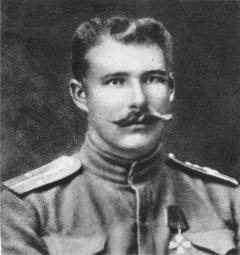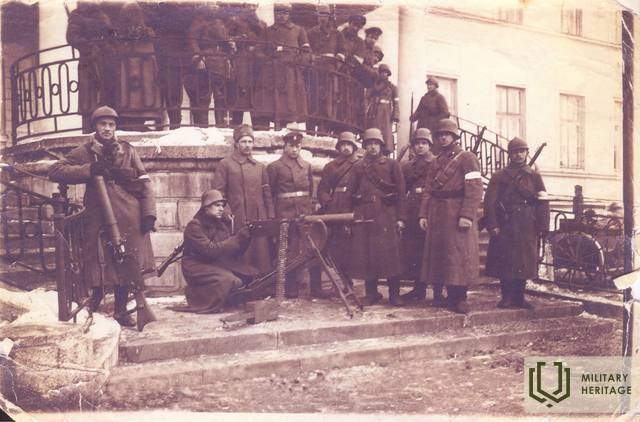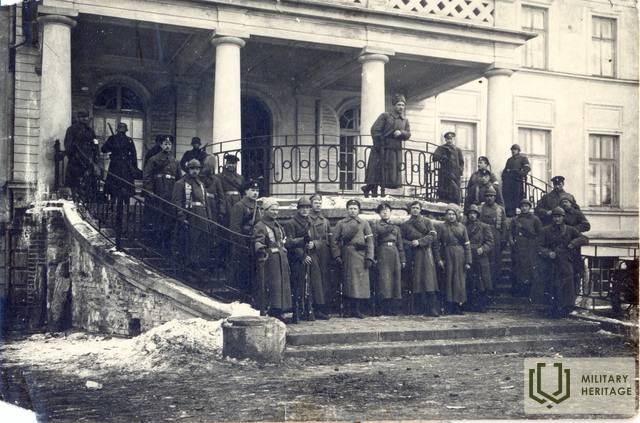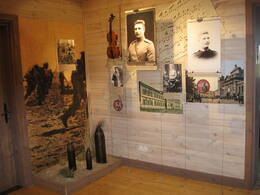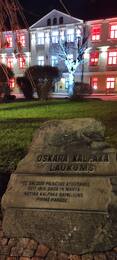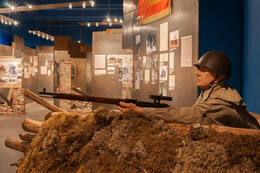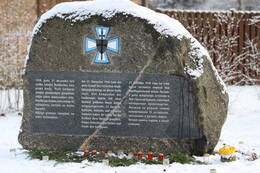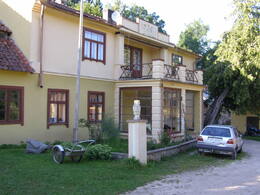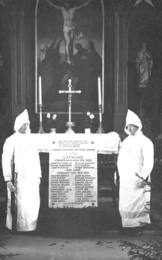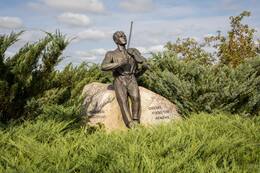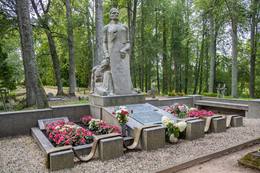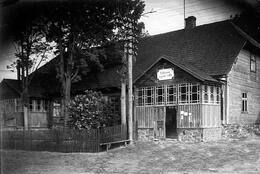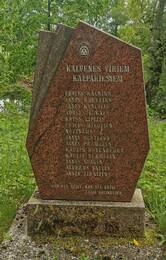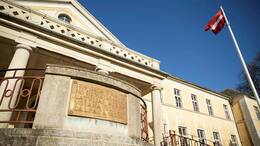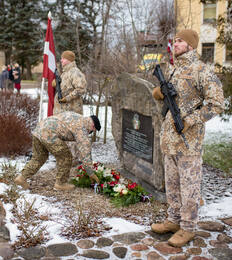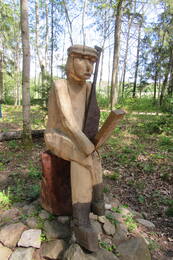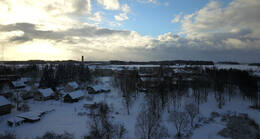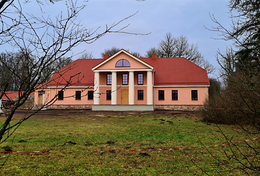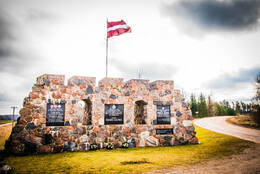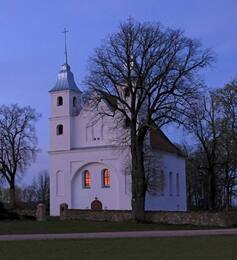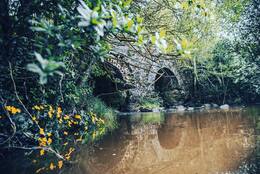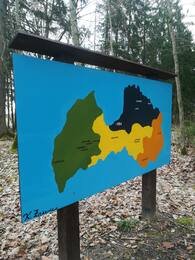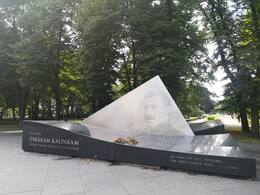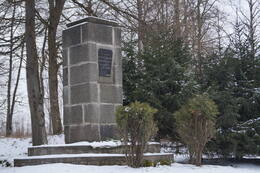Colonel Oskars Kalpaks
I World War I, I Wars of Independence
Oskars Kalpaks (born on 6 January 1882, died on 6 March 1919) was a Latvian colonel, the first commander of the Latvian units of the Latvian National Guard, also known as "Kalpaks Battalion".
Kalpaks was born in a farming family. Having decided to become a soldier he completed Irkutsk military school and then commenced service with the 183rd Pultusk Infantry Regiment. He displayed talent as a commander and heroism in battle during the First World War and was awarded the most significant Russian military decorations and made Regiment Commander in 1917.
After the proclamation of Latvia's independence on 18 November 1918, Kalpaks enlisted with the Ministry of Defence. He organised the defence of Vidzeme against Bolshevik attacks. On 31 December Kalpaks became Commander-in-Chief of all the armed units at the disposal of the Provisional Government of Latvia.
Under his leadership, Latvia's first armed formations became battle capable. On 28 February 1919, Kalpaks was awarded the rank of Colonel. From January to March 1919 the 1st Latvian Battalion fought with the German VI Reserve Corps to repel the Bolshevik raids into Kurzeme and this was the start of Latvia's struggle for liberation. On 6 March 1919 near Airītes, by mistake, Kalpaks was killed in a skirmish with German Freikorps troops.
More information sources
Col. Oskars Kalpaks's journey through the Latvian freedom struggle in Courland in 1919 https://youtu.be/OaXqKTV0qHU
https://enciklopedija.lv/ entry "Oskars Kalpaks"
Related timeline
Related objects
Oskars Kalpaks Museum and Memorial Site “Airītes”
The Oskars Kalpaks Museum and Memorial Site Airītes is located between Saldus and Skrunda near the A9 highway. The exhibit has extensive information about Colonel Oskars Kalpaks and his battalion, and shows the history of the Latvian National Army and the memorial site Airītes. The exhibit reveals Colonel Oskars Kalpaks as a personality, as a soldier and as a fighter for Latvia's independence. Audio logs in Latvian, English and German are also available as part of the exhibit. They emphasize the importance of the historic events of 1918/1919 in the protecting the statehood of Latvia. The museum building has been restored.
Entry is free; guided tour – for a fee. The complex has a recreation area, a park, an obstacle course, it is possible to take various classes, and there is a seminar hall for up to 30 people.
Memorial stone in Oskaras Kalpaka Square in Saldus
O.Kalpaka Square is located in the very centre of Saldus, at the intersection of Lielā and Striķu streets.
The former market square is today a favourite place of recreation for residents and visitors of Saldus, where concerts, commemorative events and festivities are held. On 10 March 1919, Saldus became the first Latvian town liberated by Colonel Oskars Kalpaks' battalion.
On 14 March 1919, the first parade of the Latvian Separate Battalion took place in the square, and in 1992, in honour of Colonel Kalpakas, the square was named after him.
Latvian War Museum
The Latvian War Museum is located in the Old Town not far from the Freedom Monument in a historic defence building called the ‘Powder Tower’. There are 11 exhibits in the museum. There are various weapons, documents, uniforms, awards, badges and other items detailing the everyday life of a soldier in war. The Latvian War Museum is one of the oldest museums in Latvia. Its origins can be found in World War I. Museum’s collection was made up mainly of personal items of soldiers or items found on battlefields. After Latvia gained its independence the main goal of the museum became to create an exposition on the military history of Latvia and the active role of the population in protecting their land. In 1937 the museum was expanded and was technically one of the most modern museums in Europe at that time. The Powder Tower was one of the fortification towers of Riga. Some evidence dates back to 1330 where it has been mentioned as the ‘Sand Tower’. The tower was destroyed in 1621 when Riga was besieged by the Swedish Army. But in 1650 a new tower for storing gunpowder and weapons was built. After the city’s fortifications were taken down, the Powder Tower remains as one of the most important pieces of evidence of the Riga defence system.
Monument to the first battle for Latvia's independence
Located in Inčukalns, Atmodas Street 2.
On July 3, 2016, a monument to the first battle for Latvian independence was unveiled, dedicated to the Latvian Landeswehr (Die Lettländische Landeswehr), in which local Baltic Germans, Russians and Latvians, who were in units on both sides at the time, defended the newly founded state against the Bolshevik Red Army. Eižens Upmanis, the chairman of the Brothers' Graves Committee, concluded at the time that this could be the first monument to the combined Latvian and Baltic German forces in battle memorials outside the cemeteries. At that time, Lieutenant Colonel Oskars Kalpaks was appointed commander of the Latvian units of the Latvian Landeswehr, from whose units the later Latvian Army grew and formed during the Freedom Struggle.
In 1918, the entire territory of present-day Latvia had fallen into the hands of the German Empire and its troops. However, in the late summer and autumn of 1918, the situation began to rapidly turn against Germany and it was clear that it was only a matter of time before Germany would be forced to admit defeat in World War I. The Russian Empire, which Latvia was part of until World War I, had ceased to exist earlier, with the February and October revolutions of 1917. On 18 November 1918, the Republic of Latvia was proclaimed. The German army, which was located in the territory of Latvia, after the armistice with the Entente powers on 11 November 1918, was no longer motivated for further hostilities and most of its soldiers simply wanted to return to their homeland.
Under such circumstances, it was clear that the defense of Latvia depended primarily on a national guard formed by the Latvian population itself. Initially, due to their education and relatively greater ability to self-organize, the Baltic Germans living in Latvia showed the greatest initiative in forming such a national guard. Russian soldiers also joined the national guard. In order to ensure the supply of the national guard with uniforms, weapons and other necessary resources, the Latvian Provisional Government concluded an agreement with the German representative Augustus Vinnig on December 7, 1918, providing for the provision of the national guard from the German army reserves located in the territory of Latvia. This agreement indicated, among other things, that this national guard, with the official name “Latvijas zemessardze” or in German – “die Lettländische Landeswehr”, would be the armed forces of the Republic of Latvia.
The Latvian National Guard was confronted by two Latvian Red Riflemen regiments (i.e., approximately 2,000–3,000 soldiers) that had previously been experienced in World War I and the Russian Civil War. Despite the Red Army's experience and numerical superiority, the Latvian National Guard held Inčukalna in fierce battles for two days, until finally, on the evening of January 1, 1919, in order to avoid encirclement, it was forced to retreat, losing 43 killed and several wounded, most of whom were captured by the Bolsheviks, where they were killed or died of hunger or disease.
Author: Artis Buks. Material: Fieldstone. The monument is made of a large monolithic stone that was found in Ruļļi near Jelgava.
General L. Bolstein Museum
Located 17 km from Kandava in Pūcesdzirnavas, Matkule parish.
The memorial room of Latvian Army General Ludvigs Bolšteins has been created in the Pūces mill territory, in a rest house. The property was once leased by the Bolšteins family. Since the end of the 19th century, a sawmill, a grain mill, and sheep wool processing were operating here.
Ludvigs Bolšteins was one of the most experienced Latvian soldiers, who actively participated in the creation of the Latvian Riflemen units. He participated in the War of Independence and the creation of the Latvian state. At the beginning of World War II, Ludvigs Bolšteins was an example of demonstrating complete non-cooperation with the Soviet occupation regime. One of the two highest-ranking officers of the Latvian Army who committed suicide because he did not want to cooperate with the Soviet occupation authorities. A vivid source of history is the general's death letters, which allow us to better understand the personality and the situation in which the Latvian state was at the beginning of World War II. The letters read: "To our superiors. We, Latvians, built a new, stately building - our state. A foreign power wants to force us to demolish it ourselves. I cannot participate." In turn, the text of another letter was addressed to his mother: "Mother, forgive me, I could not do otherwise."
By registering in advance, you can visit the memorial room and see an exhibition dedicated to the general.
Memorial plaques for Lubāna residents who fell in World War I and the War of Independence at the Lubāna Lutheran Church
Located in Lubāna, Baznīcas Street 1, in the Lutheran church.
A white marble memorial plaque to Colonel Oskars Kalpaks, installed in the Lubāna church during the interwar period, can be seen. On June 22, 1924, a memorial plaque was unveiled in the church to the fallen students of Lubāna secondary school. In 1926, a memorial plaque installed by the Lubāna parish to the fallen residents of the parish was unveiled, as well as a memorial plaque to the Prime Minister Hugo Celmiņš, who was born in "Nagliņa" in Lubāna parish.
Materials about Oskars Kalpaks and Hugo Celmiņš's everyday life can be viewed in the exhibition of the Lubāna Cultural and Historical Heritage and Tourism Information Center.
The birthplace of Colonel Oskars Kalpaks “Liepsalas” and the final resting place in Visagals cemetery
The Colonel Oskars Kalpaks family memorial in Liepsalas is located in the area between Madona and Lake Lubāns. Liepsalas is Kalpaks’ childhood home. The memorial site was established here in 1997 based on the ideas and using the resources of the colonel’s niece, Ārija Kalpaks-Grundmane (1922-2006). The site consists of various environmental objects and stone sculptures with a symbolic meaning, signifying Latvian ethical and patriotic values. The largest building houses an exhibit dedicated to the history of the Latvian War of Independence and the 22 years of Latvian freedom (1918-1940). Located in the Visagals graveyard, the monument to Oskars Kalpaks, created by Kārlis Zāle and Arnolds Dzirkals, was unveiled in 1927. The monument consists of a composition of three figures, in the centre of which is an ancient Latvian warrior holding a shield and a sword, with a falling soldier on each side. Placed obliquely on a granite base, a bronze plaque at the foot of the sculptural group contains engraved text, including a poem, dedicated to Kalpaks, by Edvards Virza. Oskars Kalpaks died on 6 March 1919 near Airītes, by the road from Skrunda to Saldus.
The final resting place of Colonel Oskars Kalpaks
Located in Visagala Cemetery, Madona County
On display is a monument to Oskars Kalpaks, unveiled on July 10, 1927, by Kārlis Zāle and Arnoldis Dzirkalis - a three-figure composition, in the center of which is an ancient Latvian warrior with a shield and sword in his hands, and on both sides of him are two warriors standing. At the foot of the sculptural group, a bronze plaque is placed obliquely on a granite base, on which is engraved a text that also includes a poem by Edvards Virza dedicated to Kalpaks.
Oskars Kalpaks fell on March 6, 1919, near “Airītē”, on the side of the Skrunda-Saldus road, and his remains were transferred from the Liepāja Northern Cemetery to the family cemetery in Visagala on September 18.
The monument was unveiled by the chairman of the Colonel O. Kalpaks monument committee, General J. Balodis, in the presence of the then President of the Republic G. Zemgalas, Prime Minister M. Skujenieks, Speaker of the Saeima P. Kalniņš, Minister of War R. Bangerskis and K. Ulmanis. The foundation stone of the monument was laid on June 19, 1925. The stone for the monument was taken from the colonel's native home in Siena Marsh, on this stone O. Kalpaks loved to play the violin in his childhood.
Lubāna Municipality tourism and cultural heritage centre
The Lubāna Municipality Tourism and Cultural Heritage Centre is located in the very centre of the city of Lubāna. It features several exhibits, including permanent ones, on the history, culture and traditions of and events at the municipality. The permanent exhibits are dedicated to personalities that Lubāna is especially proud of. They introduce poet Broņislava Martuževa, member of the National Resistance Movement and political prisoner; politician Hugo Celmiņš, a participant of the War of Independence; Oskars Kalpaks, First Commander-in-Chief of the Latvian Army; photographer Alfreds Grāvers; opera singer Jānis Zābers; poet Jānis Gavars; artist Rūdolfs Pinnis, as well as folklorist and pastor Mārtiņš Celmiņš. A guide describes the lives of the Knights of the Lāčplēsis War Order and freedom fighters in Lubāna and its adjacent territory, as well as their resting places in Lubāna’s old graveyard. Available languages: Latvian and Russian. Guided tours with a German and English translation can be booked in advance.
Monument and memorial markers to the soldiers of O. Kalpaka Battalion at Aizpore Cemetery
About halfway between Rudbārži and Kalvė, on the side of an old road parallel to the A9 highway, is the Aizpore Cemetery.
There is a monument and 12 memorials to the volunteer soldiers of Oskars Kalpaka's battalion, who lived in the surrounding houses.
The Aizpore half-manor of the Kalvene municipality was the farthest place to which the Latvian Separate (Kalpaka) Battalion retreated on 22 January 1919. Here the battalion received its first reinforcements from Liepāja - 35 men and launched a counter-attack, reaching Rudbārži on 24 January.
The idea of erecting a monument was conceived in the 1920s, when former soldiers of the 1st Latvian Separate Battalion, or Kalpaka Battalion, erected a temporary memorial sign - a block of oak with a plaque. At that time, the idea of creating a larger memorial ensemble was born, but it was only realised on 15 May 1993, when the memorial sign - the Ray of Light - was unveiled - an obelisk made of grey granite.
The 2.3 m high memorial sign is made by sculptors Harijs SPRINCIS and Imants LUKAŽIS (1930 - 2007, buried in Aizpuri Cemetery), whose father was also a soldier of O. Kalpaka's battalion. The names of the poet E.VIRZA are engraved on the memorial sign:
KALPAKAM
AND HIS
TO THE SOLDIERS
1919
MORNING OF 25 JANUARY
FROM THIS DAY
ALSO FROM
FIRE
OVER LATVIA
At the same time, the graves of the 12 Kalpaks buried in the cemetery were marked with oak memorial plaques, which were replaced by granite markers in 2019.
In the early 1990s, a two-metre-high monument was erected in the cemetery, next to which grows an oak tree planted in the mid-1990s by the legendary actor Ēvalds Valters.
Rudbārži Manor Castle and memorial plaque to the 1st Latvian Separate Battalion
The castle is located in Rudbārži, on the Riga - Liepāja A9 highway. A memorial plaque commemorating the deeds of Oskars Kalpaka's battalion is placed in front of the building.
The castle was built in 1835 as a property of the Baron von Firks family on the order of Baroness Thea von Firks. On 15 December 1905 the manor house was burnt down by revolutionaries. Restoration work under the direction of architect L. Reiniers began three years later.
During the Latvian War of Independence, Rudbārži Castle served as a base and headquarters for combat operations on the banks of the Venta River, commanded by Colonel Oskars Kalpaks' 1st Separate Latvian Battalion.
Later, the castle was used as a recreation base for Latvian army soldiers. In 1938 the castle was rebuilt.
During the Second World War the building housed a hospital for German army soldiers, and in the post-war years - a school for forest workers. In 1962 the castle became the Rudbārži School, which was named after Oskars Kalpaks in 1991. The Hall of Heroes of Rudbārži Manor was restored in 2016. The school is currently closed, but in the coming years the building is planned to house a vocational military secondary school named after Oskars Kalpaks.
Battle of Skrunda Memorial and Flag Day
The Skrunda Battle Memorial is located in the centre of Skrunda, in Oskaras Kalpaka Park near the Skrunda Culture House, at the intersection of Kuldīgas and Liepājas Streets. In 2005, a stone was erected at the memorial commemorating the battle of 29 January 1919, when the battalion commanded by Oskars Kalpaks, together with the German and Russian units of the Landeswehr, liberated Skrunda from the Bolsheviks. The tradition of Flag Day has been maintained since 2004, commemorating the first town liberated from the Bolsheviks and its liberators, who raised the Latvian flag at the Skrunda church on 29 January 1919.
During the first months of the War of Independence, the Latvian Provisional Government, under pressure from the Bolsheviks, was rapidly losing territory. On 22 January 1919, the Bolsheviks captured Skrunda. A week later, in the early hours of 29 January, the offensive to recapture Skrunda began. The Latvian Separate Battalion under Lieutenant Colonel Oskars Kalpaks was to attack along the Rudbāržu-Skrunda highway and drive the Bolsheviks out of Skrunda. This would be followed by a flank attack by German units with the task of destroying the advancing enemy, while the Russian company would attack between the Latvian and German units, using the Skrunda church as a landmark. The attack was also supported by a German artillery battery. On the day of the attack, the frost was 15 degrees, the sun shone brightly, the Kalpaks had to cross a clear field, and the Bolsheviks were sheltering in the stone buildings of the manor. The Bolsheviks opened fire when the chain of attackers was about 300 metres away, a two-way firefight broke out, and the soldiers under Oskars Kalpaks' command advanced in a rapid advance, forcing the enemy to cease fire and retreat across the Venta. After about 3 hours of fighting, Skrunda was captured at about 9am, with the Latvian Separate Battalion having only 2 wounded.
The Battle of Skrunda was of great importance for the morale of the Latvian Provisional Government's armed Spek soldiers, as it was in fact the first significant victory in the battles against the Bolsheviks. Moreover, the commander himself, Oskars Kalpaks, showed particular courage in the battle, encouraging the soldiers by his example not to be afraid.
"Nature - Strength Trail" of Oskars Kalpaks Museum
The nature trail was created in the territory adjacent to the museum and is based on the idea of the design of the O. Kalpaks Museum and its surroundings in 1936.The nature trail is free of charge for individual museum visitors.
The nature trail features wooden sculptures created during a woodworkers' plein-air workshop organised by the Kuldīga Technology and Tourism Technical School on the unifying theme - "For the Love of Freedom". Also on display are large-format paintings from the plein-air "Guard your Fatherland!" artworks painted by teams of schoolchildren from the surrounding regions.
A mini-air-track has also been created in the nature trail for the youngest visitors of the museum.
Jaunmuiža and the 1st Latvian Separate Battalion
Nowadays Jaunmuiža, formerly Jaunāmuiža, is a populated place in Kuldīga Municipality and is located on the road Skrunda - Ezere, 7 kilometres. The settlement was established on the site of the former half-manor house of Jaunā manor (Neuhof).
On 3 March 1919, an intense battle took place for this place between units of the 1st Latvian Separate Battalion led by Colonel Oskars Kalpaks and units of the 2nd Soviet Latvian Rifle Regiment.
On 3 March 1919, Operation Tauwetter (Thaw), the liberation of Courland, began, in which the VI Reserve Corps of the German Army, with the Landeswehr and its 1st Latvian Battalion, launched an offensive across the front with the intention of pushing the Bolshevik units back to Lielupe. In the early morning of 3 March, units of the 1st Latvian Separate Battalion - Cēsis Company, Student Company and Cavalry Division, reinforced by the artillery battery of German Hauptmann Müller, crossed the Venta at Lėnai and attacked the Jaunai Manor, defended by the 2nd Battalion of the 2nd Soviet Latvian Rifle Regiment. During the several-hour-long battle, gradually occupying the houses in the vicinity of Jaunā muiza, Kalpaka's commanded units reached Jaunā muiza and intercepted the Skrunda-Pampali highway, interrupting the enemy's movement and pushing the enemy eastwards. In Jaunāmuiža the battalion received stationery and ammunition as trophies. Taking up positions in nearby houses the battalion fortified itself. On 5 March the Bolshevik counter-attack began, which was stopped by the evening. On 6 March the battalion resumed the attack, taking the Skrunda school and advancing towards the Airite - Aizupji area.
Lēnu Manor
The manor castle is located in the village of Lēnu, by the Venta River. The castle is currently privately owned and can therefore only be seen from a distance.
The manor house was used as a support point by the 1st Latvian Separate Battalion from the end of January to 3 March 1919. The Latvian Separate Battalion had to liberate the surroundings of Leni Manor in order to be able to cross the river opposite Jaunmuiža.
The manor belonged to Baron Friedrich von Firks, who also owned the Rudbāržzi and Sieksate manors. The manor house was built in the 19th century. For the Baron, the castle of Lēnu served mainly as a place for hunting and weekend relaxation.
From 1927 to 1937 the castle was a school, and during the Soviet occupation it was a collective farm woodshop. In 1965, a community centre was opened. The ensemble of buildings has suffered many alterations and the park has not been preserved. Several outbuildings have survived.
Memorial to the 1st Latvian Separate Battalion in Lėnai and relocation site on the Venta
The monument is located in Lēņi, at a road crossroads near Lēņi Manor.
The monument was unveiled on 8 November 2007. It was designed by sculptor Maija Engele. The author and financier of the monument is Jānis Blūms, whose father, Lieutenant Paulis Blūms, 1st Lieutenant of the 1st Separate Latvian Battalion Cavalry Division, organised and led the river crossing on 3 March 1919 with the help of 10 men.
Every year on 3 March, young guards, servicemen and other interested persons gather here for a commemorative event in honour of the 1st Latvian Separate Battalion.
Holy Trinity Roman Catholic Church in Lēni
The church is located in the village of Lēnu, Nīkrāce parish, Skrunda municipality, on the Skrunda - Embute road.
The Venta River is located near the church, the banks of which were guarded by soldiers of the 1st Separate Latvian Battalion in February 1919. As the battalion's numbers did not allow for a continuous front line, the front was guarded by sentry posts. One of them was also located on the bank of the river near the church. The church towers were useful for surveillance of the surrounding area and the other side of the river.
Battle at Skrunda school
Skrunda School is located in Pumpuri, at km 3 of the Skrunda - Ezeres road. The school is privately owned and can therefore be viewed from a distance.
In January and March 1919, the 1st Latvian Separate Battalion fought with units of the 2nd Latvian Rifle Regiment of Soviet Latvia near the school.
The battle near Skrunda School took place on 22 January 1919. In the face of the retreating Bolshevik superiority, German and Latvian units positioned themselves on the western bank of the Venta, while Bolshevik forces gathered in Saldus in preparation for a wider operation, at the same time sending some of their forces in the direction of Skrunda. In order to seize the initiative and try to defeat the Bolshevik forces piecemeal, on 22 January the Cēsis Company of the 1st Latvian Separate Battalion, reinforced by 15 soldiers of the Officers' Company and the German Raden Company in the Skrunda sector of the front, had to attack towards Saldus. The Skrunda School was designated as the assembly point for both companies. However, during the preparatory phase of the attack, both companies were surprised by a Bolshevik attack, which forced the German and Latvian units to retreat to Rudbārži.
The second clash at Skrunda School took place on 6 March 1919, when the Cēsis and Student Companies of the battalion commanded by Colonel Oskars Kalpaks surprised the enemy and captured Skrunda School and continued to advance towards Dutēni, Engurnieki and Airīte.
On the side of the Skrunda-Ezeres road, near the school, where the road crosses the Klūga river, there is a small, ancient stone bridge from the late 19th century with two semi-arched arches for the river to pass through. The road leading over the bridge used to be used in the past, but is now gradually becoming overgrown with grass as the adjacent tarmac road and bridge are now used. From this bridge, the stone bridge offers a magnificent view, enriched by the rocky riverbed and the banks covered with thick trees. The site is visually very attractive and suitable for cycling or walking routes.
Oskara Kalpaka Museum military-educational task track "The Way of the Schoolboy Company"
The task track "The Way of the Schoolchildren's Company" is an attraction in the O.Kalpaks Museum territory, where there are 7 tasks of different complexity to be performed in teams (minimum number of participants per team - 3)
A Monument Dedicated to the First Battle of Oskar Kalpak’s Battalion in Lielauce
A monument dedicated to the first battle of Oskar Kalpak’s battalion is situated next to the ruins of Lielauce Lutheran Church. It was erected at the site of the battle of Kalpak’s battalion, which took place on the night of 15 to 16 January 1919. In the battle, two companies of Kalpak’s battalion repelled an attack by an entire Bolshevik battalion and a squadron of cavalry. It was the first important battle of Kalpak’s battalion. As the Landeswehr lost the battle in Auce, the decision was made to retreat and hold the front at a natural obstacle – the River Venta.
The monument was unveiled on 19 August 1934 in the presence of the former fighter of the battalion, Minister of Agriculture, J. Kauliņš. The monument was designed by an architect P. Dreimanis and manufactured by J. Sieriņš. The monument is made of grey granite blocks, with a black granite plaque at the front with the following inscription: “The battle of Colonel Kalpak’s battalion took place here on the night from 15 to 16 January 1919.” Four soldiers were killed in action.
The monument was destroyed in the early 1950s and the plaque was smashed. It was restored in 1991 by using the original plaque, which had been split in two. In the restored monument, the plaque no longer faces the church, but the centre of Lielauce.
The first battle of Lielauce Castle and the Oskars Kalpaks battalion
The Lielauce Manor with its park is an object that is associated in Latvian history with the First Battle of Kalpaks, which took place during the War of Independence in January 1919, and its victory. The current manor building ensemble was basically formed at the beginning of the 19th century. The manor house was originally built in the Empire style as a two-story building with a tiled roof. The farm buildings of the complex are located further away from the manor park. The manager's house, which was later rebuilt into a cultural center, stables, a servants' house, and an ice cellar on the pond side, have survived. Only the foundations of the granary built in 1801 remain, but the volumes of the cone kiln, although rebuilt, have been well preserved. The manor's cart house or soldiers' barn can also be viewed.
After the establishment of the Latvian state, the Lielauce Manor building with the adjacent lake, park, buildings and a certain area of forest was first transferred to the establishment of an orphanage, but it was not established. In November 1926, the Forestry Department of the Faculty of Agriculture of the University of Latvia took over the Lielauce Castle, granted by the Central Land Committee for the organization of training practices, with its park and land of 59 hectares. After the Second World War, until 2009, there was a Lielauce Primary School here, but at the same time also a LLU service hotel. Currently, the manor and park are owned by SIA “Mudia”. Until the technical condition of the manor is improved, it is not available to visitors.
On the night of January 15, 1919, the Kalpaks Battalion fought the first battle at Lielauce, repelling the Red attack. It was the first significant battle of the Kalpaks Battalion, when the victory gave the soldiers a particularly strong morale boost.
During the retreat, on January 12, the Latvian separate battalion reached the Lielauce Manor Castle and settled there to rest, setting up guard posts on the surrounding roads. Early in the morning of January 16, the guards noticed the enemy approaching along the Dobele highway and managed to warn those in the castle. The first to engage in the battle was the Officers' Reserve Company, which had taken up positions near the manor building. The Cēsis Company, divided into two parts, tried to surround the enemy. At first, the Bolsheviks retreated, but then they launched a counterattack, which the Cēsis Company managed to repel. The enemy was forced to retreat. The first victory against the Bolsheviks had been won. Although the Kalpakians suffered four casualties (Lieutenant Kārlis Dambītis, Lieutenant Fridrihs Liepa, War Clerk Vilis Cīrulis and Instructor Jānis Būvmeistars) and eight wounded, the outcome of the battle encouraged the soldiers to continue fighting the enemy. Unfortunately, on the same day, the Latvian Separate Battalion was forced to abandon its positions, as the German Raeden Company lost the battle at Vecauce and retreated.
Related stories
Colonel Kalpak's last battle near Airīte
Colonel Kalpaks was a respected figure in military circles and a true patriot. It was the spirit of patriotism and an unfortunate coincidence that led to the fatal clash between him and the German battalions, which unfortunately ended with the death of Colonel Kalpaks.
The Battle of the Oskars Kalpaks Battalion at Lielauce
On the night of January 15, the Kalpaks Battalion fought the first battle at Lielauce, repelling the Red attack. It was the first significant battle of the Kalpaks Battalion, and the victory gave the soldiers a particularly strong morale boost.
The life of General Jānis Baložs after his return from exile
When in 1940 the Russians tried to squeeze a favorable military base agreement from the Latvian government, which would make the Latvian army's ability to resist the Red Army almost impossible, General J. Balodis tried to get some amendments to the agreement. However, this did not work. But the general's detractors used this circumstance to later make J. Balodis almost a traitor. After a conflict with the Prime Minister and State Minister K. Ulmanis, the general was dismissed from the post of Minister of War on April 5, 1940. Then J. Balodis decided to participate in the Saeima elections from the Democratic Bloc, but nothing came of it, because only one list was allowed to run in the elections - the list of communist candidates. Latvia became the 14th Soviet republic.
In memory of Oskars Kalpaks
The memory of Oskars Kalpaks is preserved in many places – this is evidenced by his native Liepsalu house, a monument in the Visagala cemetery, commemorative events and beautiful concerts on March 6, the Meirānu Kalpaks Elementary School, streets in Lubāna, Madona and other cities, and on and on. But in this article – about the preservation of the memory of Oskars Kalpaks in his native region in the 1920s–1930s.
General Ridiger von der Goltz's visit to Rudbārži in February 1919
In February 1919, after a successful anti-German campaign in Finland, German General Ridiger von der Goltz was appointed commander of the German armed formations in Courland and Northern Lithuania, including the Landwehr, which included the 1st Latvian Battalion. During his visit to the front in February 1919, he also arrived in Rudbārži. Lieutenant Jānis Ķīselis, the battalion's special task officer, described the General's visit in his memoirs.
The 1st Latvian Separate Battalion crossed the Venta on March 3, 1919
One of the main challenges for the units of the 1st Latvian Separate Battalion was to cross the frozen river Venta and build a road across it.
Captain Aleksandar Leving's memories of a reconnaissance expedition over Venta near Lenas
In February 1919, both sides of the Venta River were active in reconnaissance activities. Captain Alexander Loeving, Chief of the Cavalry Division, was one of the commanders of the reconnaissance raids.
Battle of Skrunda School on January 22, 1919
Memories of Lieutenant Commander Jānis Ķīselis about the battles at Skrunda School on 22 January 1919
Aizporis Manor during the War of Independence
Aizporu Half Manor, Aizpute district, Kalvene municipality, is the westernmost place in Latvia to which Colonel Oskars Kalpaks' separate battalion retreated.
Halfway between Rudbārži and Kalvenė, on the side of the road, is the Aizpore cemetery. There is a monument and 12 memorials to the volunteer soldiers of Oskars Kalpaka's battalion.
Latvian Army armored train No. 5 or "Kolpaks"
Latvian Army Armoured Train No.5 or "Kalpaks" was a light armoured train in the Latvian Armed Forces in 1919.




